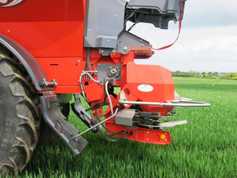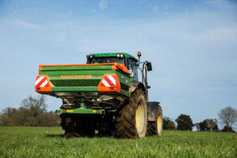“Man … despite his artistic pretensions and many accomplishments … owes his existence to a six-inch layer of topsoil and the fact that it rains” – AnonymousSoil Mapping in Ireland is difficult, and the reason is ice. Imagine a bulldozer rampaging, albeit at snail’s pace, around your fields with complete disregard for boundaries, barriers or grading.
“Man … despite his artistic pretensions and many accomplishments … owes his existence to a six-inch layer of topsoil and the fact that it rains” – Anonymous
Soil Mapping in Ireland is difficult, and the reason is ice. Imagine a bulldozer rampaging, albeit at snail’s pace, around your fields with complete disregard for boundaries, barriers or grading.
Now imagine that the blade on that bulldozer is nearly a kilometre high and it started its journey through your fields somewhere north of Scotland, scraping and pushing all before it. This is in effect how our history of ice ages and glaciation has affected the Irish landscape. While in parts of the country the evidence is more obvious such as in the classic drumlin landscapes of Cavan, Leitrim and Clare, in other areas the evidence is not nearly so apparent on the surface. However, when the thin skin of vegetation is removed, the scale of the impact is revealed and the complexity of our underlying soils becomes clear.
Bedrock was torn up and ground down by the overwhelming power of the ice sheets as they travelled southwards form the Arctic, covering all of Ireland with the exception of a handful of the highest summits. The sediment was ploughed up and bound into the ice mass and transported before being redeposited again as the ice mass melted and receded. When the ice finally retreated, this grand-scale reworking of Irish substrates left a landscape draped several metres thick in surface glacial till, or boulder-clay, of very mixed geological origin. It is from this till that the soil formation was initiated and it is commonly referred to as the soil parent material to reflect its role in soil development.
Given this geological history, it is clear why Irish soils are so complex. Limestone till frequently overlies sandstone bedrock and vice versa; granite stones are intermixed with other rock types in the till mass and in many cases multiple rock types are mixed through the parent material, influencing subsequent soil formation. On the east coast, mud from the Irish Sea was dragged inland – in some cases up to 60km from the coast.
The effect of such varying underlying parent material means it is a far from straightforward task to map Irish soils. In some areas of the world, where glaciation did not take place, soil mapping can be an uncomplicated affair. Of the 11 major soil types found in Ireland, nine were once mapped in a field in Cork.
It is into this environment that the original practitioners of soil survey in Ireland ventured. By virtue of considerable foresight by the leaders of the National Soil Survey in Ireland, some of these were dispatched overseas to learn soil mapping techniques before returning home to practise them in the Irish landscape.
Although the work undertaken by members of the previous National Soil Survey was of a very high standard, to restart the soil survey from where it had ended using traditional methods was not an option due to the potentially prohibitive expense. Instead, Teagasc, among the first to do this, proposed an innovative approach, based on the use of geographic information system (GIS) technology and advanced predictive mapping techniques. This approach has enabled a new National Soil Map and associated soil information system to be created in only five years at just 12% of the cost of the alternative, traditional approach.
The previous outputs of the National Soil Survey, specifically the county maps at a scale of 1:126,720, were used. More recent map products, such as the Indicative Soil and Subsoil national map series completed by Teagasc in 2009, were also included. Incorporation of this pre-existing soil information allowed the development of predictive mapping techniques, which used statistical models describing the variation of soil within and between landscapes.
Given the diversity and complexity of Irish soils, however, it was essential to combine this modern approach with a field programme to provide verification of the modelled soil-
landscape relationships. Over the course of two-and-a-half years, in a manner reminiscent of the traditional approach taken by the National Soil Survey, teams of surveyors travelled to locations throughout the country to collect soil samples and make landscape observations. However, unlike their An Foras Talúntais predecessors, these teams were equipped with GPS-enabled field tablet computers with GIS technology installed, which enabled them to verify locations and assess the validity of the computerised models while in the field. In total, Teagasc staff assessed and analysed over 10,000 soil auger samples from the field.
A second, more detailed, assessment was then carried out in which 225 soil pits were dug in order to describe reference soils for Ireland in full detail. These pits were sampled at all horizons down the soil profile and a suite of laboratory analyses were conducted to allow the classification of the soils, using both the Irish classification system and the World Reference Base (WRB) system, the main unifying classification system used in Europe. These analyses included: pH, texture; organic matter; total nitrogen; extractable iron and aluminium; bulk density; cation exchange capacity (CEC); and base saturation.
The new 1:250,000 map along with associated data is currently openly and freely available to the public and all interested stakeholders. The map can be accessed via a standard web browser and allows normal online map functions such as panning and zooming in to areas of interest. By means of clicking on a location, access is also provided through the web browser to the data in the underlying database. This data describes in detail the 58 soil associations and the physical and chemical characteristics of 213 soil series that make up the various associations.
It is vital for users to familiarise themselves with the appropriate way in which the map should be used. Like all map products this is driven by the linked cartographic concepts of Minimal Mappable Unit (MMU) and the scale of map production and publication. While in modern map systems viewed on computers, users can often zoom in to ever more unrealistic level on screen, the fundamental concept of the MMU doesn’t change. The MMU describes the area of the smallest unit possible to represent on the map at the scale of publication. At 1:250,000 scale, the MMU is approximately 250ha. In other words the smallest area that can be represented with any degree of confidence is about the size of roughly 38 Croke Parks, or about eight average-sized Irish farms.
There can be a sense that when a map is produced that the national soil mapping initiative is complete. However, the reality is that there is no one, singular map of any country no matter how large or small. Instead there must be multiple maps depending on the scale and level of detail required by the various and diverse applications for which soil map information is required.
Comparisons are sometimes made with the development and status of soil mapping in the US, where mapping in some agricultural areas is completed to 1:24,000 scale and greater, a full order of magnitude higher than the current Irish map. The reason is simple; investment. Every year, the voted annual expenditure to the USDA Soil Survey effort is $80m. While America’s land area relative to Ireland’s may be seen as justification for the massive difference in allocated resources, it should be borne in mind that acre for acre, an equivalent annual expenditure in Ireland would be approximately €730,000, or 17c per agriculture hectare.
Expenditure in the US is underlain by a belief in the fundamental importance of the knowledge of soils and the development of soil mapping and the commitment of the required resources over long time periods to achieve these aims. Perhaps this determined approach towards the acquisition of soils knowledge for the benefit of society is encapsulated in the admirably defiant response from a previous Director of the Illinois Soil Survey to the Comptroller of the University of Illinois when requested to estimate the cost to complete the soil survey of the state:
“I hope that my answer to your question is clearly indicated in what I have written. It is that the soil survey will never be completed because I cannot conceive of a time when knowledge of soils will be complete. Our expectation is that our successors will build on what has been done, as we are building on the work of our predecessors.” – RS Smith, director,
Illinois Soil Survey
Building on the work of our own AFT predecessors, with the latest contribution to soil mapping in Ireland, the new National Soil Map has been a remarkable achievement over a relatively short space of time and points towards exciting possibilities for the future. It is attracting significant attention both nationally and internationally due to the application of new technology with its associated significant cost reductions and the implications for the future of agriculture and the environment data generation and use. Soil is and always will be essential for life on Earth. Now, however, knowledge about soil is just as essential and will play an increasingly vital role in helping us to develop our land-based activities in a more sustainable way.





SHARING OPTIONS: